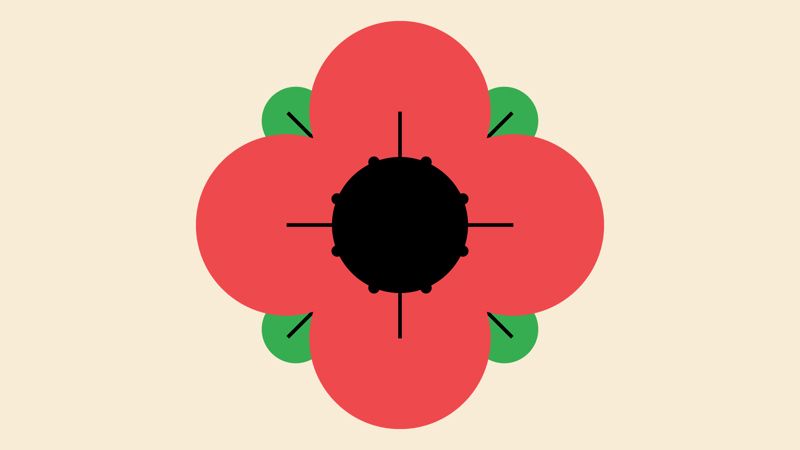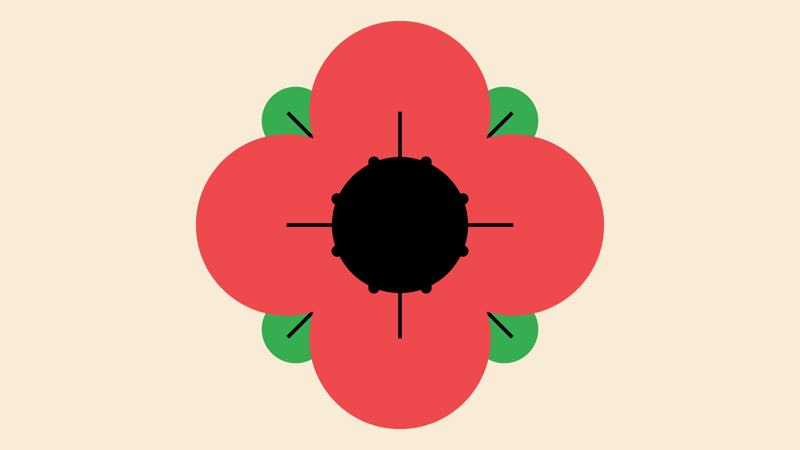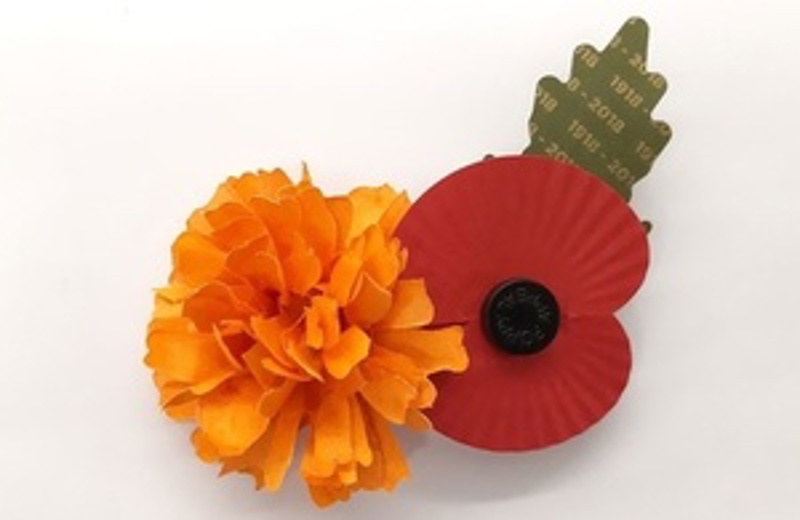
Scouts’ Own: be-leafs
You’ll need
- A4 paper
- Coloured pens or pencils
Visit the Remembrance Glade
Located at the National Memorial Arboretum in Staffordshire, the Remembrance Glade has been designed to offer a tranquil space for families, individuals, schools, community groups and others to contemplate what Remembrance means to them and to remember those that have served and sacrificed. The Glade has been created to provoke reflection and contemplation through symbolic forms, features and plants.
Plan your tripRemembrance honours people who serve to defend our democratic freedom and way of life. We unite across faiths, cultures and backgrounds to remember the service and sacrifice of the Armed Forces community from the United Kingdom and the Commonwealth. We will remember them.
- We remember the sacrifice of the Armed Forces community from the United Kingdom and the Commonwealth.
- We pay tribute to the special contribution of families and of the emergency services.
- We acknowledge innocent civilians who’ve lost their lives in conflict and acts of terrorism.
Remembrance doesn’t glorify war and its symbol, the red poppy, is a sign of both Remembrance and hope for a peaceful future. Wearing a poppy isn’t compulsory but it’s greatly appreciated by those who it’s intended to support. When and how you choose to wear a poppy reflects your individual experiences and personal memories.
Remembrance unites people of all faiths, cultures and backgrounds, but it’s also deeply personal. It could mean wearing a poppy in November, joining with others in your community on a commemorative anniversary, or taking a moment on your own to pause and reflect. Everyone’s free to remember in their own way or to choose not to remember at all.
- Armistice Day is the 11 November. It marks the armistice agreement that bought an end to the fighting of the first world war.
- People pause at 11am on the 11 November to remember service and sacrifice past and present.
- The national service of Remembrance happens on the closest Sunday to 11 November, which is known as Remembrance Sunday. Each year people gather at the Cenotaph in London and other memorial sites.
- We call the whole period around these dates Remembrance. There are many ways to take part in Remembrance
In 2022, the Royal British Legion remembers the Service of those who work to protect us and our ways of life. Whether in the Armed Forces, Emergency or Civilian Services, past or present, we remember who has served, how they served and why it’s important that we continue to remember them.
Scouts have always taken moments to reflect together. A Scouts’ Own is the perfect opportunity for everyone to spend time sharing a topic. Scouts’ Owns are often themed, for example, the theme could be friendship, using resources wisely, or a special occasion such as new year. They should be informal and they shouldn’t take ages – most can be done in 15 minutes.
It’s up to you exactly what your Scouts’ Own looks like and what you include. The best Scouts’ Owns get everyone involved with the preparing and presenting – it’s not something that adults do for young people.
If you’re looking for a helping hand planning your first few Scouts’ Owns, this activity is one example of what you could do. It’s usually helpful to think about including an opening, reading, activity, music, reflection, and closing. You don’t have to stick to this – find out what works best for your group. Whatever you do, make sure it includes everyone and is culturally appropriate.
Opening
- The person leading the Scouts’ Own should make sure that everyone who’s presenting feels comfortable and knows what they’re doing. If they need to, they should take some time to reassure people.
- Everyone should gather together and get comfortable wherever they are.
- The person leading the Scouts’ Own should introduce the opening thought.
- In this example, the Scout’s Own will focus on how skills, attitudes, beliefs, and values make everyone unique. Just like a plant, different aspects of all of these things can look and feel different for everyone.
- This's also true for Remembrance. Our different skills, attitudes, beliefs and values combine to make each person’s own Remembrance. Remembrance unites us, but we all experience it in a different way.
Reading
- Hand out copies of the reading that's been chosen. One between two is usually OK.
- The Royal British Legion have created a template Act of Remembrance that you could use if running this ceremony during Remembrance tide.
- Someone should read the reading. This could be an adult volunteer, young leader, young person or people could take a line each. Everyone else should follow the words along.
All plants have a humble aim: to survive and grow;
but every plant is different, that’s something we all know.
Some plants welcome insects, with flowers blooming bright;
others have thorns to give a mighty floral fight.
Some plants have deep roots, to take water from the ground,
others have big leaves to gather rain that tumbles down.
Some plants stand alone, on the hills and mountains high,
other plants cling on tight before they wind and climb.
Some plants bear tasty fruits for animals to eat,
Others can be poisonous – they’re the ones to leave.
Roots
- Roots keep the plant in the soil and hold it up. They also take in water (and nutrients) from the soil.
- Your roots could be long or short, wriggly or straight. You could have a few roots, or absolutely loads.
- Whatever they look like, your roots could represent different things. For example, how firmly you believe in something or how you do your best to stick at it, or how you find the best in every situation.
Stalk
- The stalk holds up the plant and carries water and nutrients to the leaves.
- It’s up to you how thin, tall, and flexible your stem is.
- Whatever it looks like, your stem could represent different things. For example, you could label it with what keeps you strong. It could also show whether you prefer to stand on your own like a tree, in small teams like flowers, or as part of a big group like grass.
Leaves
- The leaves take in sunshine and use it (as well as carbon dioxide and water) to make food, which helps the plant grow. Some leaves also take up rainwater.
- You could draw loads of small leaves, or fewer big ones. Are they glossy and smooth, or rough? What colour are they?
- Whatever they look like, your leaves could represent different things. For example, how well do you take advice and lessons from others, or how you use praise and criticism to grow.
Fruits, seeds, flowers, and thorns
- Seeds travel differently – they might glide or float through the air, burst, cling on to animals (so they travel with them and fall off somewhere else), or be part of fruit that animals eat and transport somewhere else when they go to the toilet.
- As well as providing seeds, flowers can make a plant welcoming, or warn off insects and animals.
- You could have loads of fruit and flowers, or few and far between. They could be all sorts of bright colours, or gentler pastels.
- Whatever they look like, your fruit, seeds, flowers, and thorns could represent different things. For example, how welcoming you are, whether you need to get to know someone really well before you get close, or how you interact with others.
- Some flowers and fruits could represent specific skills and talents, like giving gifts or sharing, and how your seeds travel could represent how you like to communicate.

The red poppy's a symbol of both Remembrance and hope for a peaceful future. Poppies are worn as a show of support for the Armed Forces community.

In 2018, the United Service Institution of India chose the marigold as a symbol of Remembrance for India. It was selected as it's widely available and its colour, saffron, which represents sacrifice.
Grow yourself activity
- Everyone should get some paper and coloured pens or pencils.
- People should imagine that they’re a plant. They should draw or write their features on their piece of paper. How does their plant represent them?
- Come together as a group and share their plants. What do they have in common?
- Everyone should think about how their plants could help them to support each other. How could they use their talents to support others with the things they find tricky
- People could also think about how their plants could help them to take part in Remembrance and help others to take part in it as well. How might combining their different ideas help them create a new way to mark Remembrance?
Fruits and thorns thoughts and closing
- Everyone should think about how different people are a bit like different plants. They all have unique skills and features that they use for different reasons. How can people do their best to have a balance of fruit and thorns?
- Now, think about how plants can work together. For example, it’s not helpful if one plants takes all the light and leaves others in the darkness. How can everyone help each other to succeed?
- Everyone should think about how when people share their beliefs and values, they often find that they have things in common. There are often times people can help and support each other.
- It’s important to remember that everyone’s equally important – get the light that you need and help others to get what they need too.
- The person leading this activity should thank everyone for taking part in the Scout’s Own, whether they took a big or small part in planning, leading or joining in.
Reflection
This activity was all about developing beliefs:
- Do people often have the chance to reflect on what they believe, and what makes them unique?
- How did people feel about sharing their beliefs with others?
- How did people feel when they heard other people’s beliefs?
- How does understanding the beliefs of others help us to work together and find new ways to remember?
This activity was also about caring. Unlike plants, people get to choose many of their actions, though lots of factors shape the things they do. How could people choose to grow certain aspects of themselves to help others?
Safety
All activities must be safely managed. You must complete a thorough risk assessment and take appropriate steps to reduce risk. Use the safety checklist to help you plan and risk assess your activity. Always get approval for the activity, and have suitable supervision and an InTouch process.
People could explain their plant idea in any way that works for them. They could write, draw, make models, or even use photos.
Make it accessible
All Scout activities should be inclusive and accessible.
If anyone found a skill they’d like to develop, or something they’d like to share with others, support them to make a plan to get it done.


